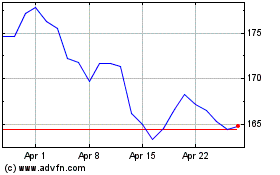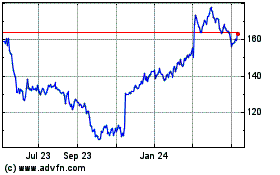By Laura Stevens And Loretta Chao
For the past two years, Amazon.com Inc., Wal-Mart Stores Inc.,
Target Corp. and other big retailers have been flinging up
warehouses and distribution centers across the country to get their
online orders to customers faster.
In the coming holiday sales season, that building spree could
come back to bite them--and the companies that deliver their
packages.
With the nation's unemployment rate at a seven-year low as
holiday hiring begins to pick up, some retailers and logistics
contractors are already struggling to find enough seasonal workers
to keep their new facilities humming. Soon, United Parcel Service
Inc., FedEx Corp. and smaller regional delivery firms will be
facing the same problem.
Employment agencies for retailers and logistics companies say
they are having trouble finding warehouse workers to stock early
holiday inventory and employees to train for work in fulfillment
centers, where holiday orders will be packed and shipped.
Few could have predicted the nation's unemployment rate would
fall to 5.1%, as it did last month, amid such red-hot growth in
e-commerce. As a result, retailers and delivery companies expect to
have to raise starting pay in some places.
For last-minute cybershoppers, the labor shortage may make the
coming holiday season even riskier than the previous two, when
Amazon and other retailers gummed up the works by trying to ship
too many packages in the final days before Christmas.
"Last year was the first year that companies felt some challenge
[finding workers], and this year they're feeling it even more,"
said Craig Rowley, leader of the retail practice at Hay Group, a
provider of human-resource services. "Between the low unemployment
rate and, hopefully, a good Christmas, it's going to be tough."
The crunch has spurred some retailers to start holiday hiring
earlier than usual. And they are trying to figure out how to be
flexible enough to accommodate employees who can only work certain
hours or shifts.
Starting warehouse wages, which have been stagnant for years,
have been rising by about $1.50 to $3 an hour to attract workers in
some markets, according to logistics staffing firm ProLogistix. The
firm said that in this holiday season, temporary jobs--especially
at e-commerce companies--start in a range of between about $11 and
$13.50 an hour, up from between about $9 and $11, though it varies
significantly by region.
Ozburn-Hessey Logistics LLC, a third-party logistics provider,
is raising its hourly wages by about 10% in some markets to compete
for talent in e-commerce hot spots, such as around Louisville, Ky.,
and Memphis, Tenn., where UPS and FedEx, respectively, operate some
of their biggest package-sorting hubs.
OHL, which typically employs 8,000 in 130 warehouses, plans to
increase its staffing by between 35% and 40% during the
holidays.
"There are a lot of warehouses there, and the market's
saturated. In some areas, the unemployment rate is as low as 3% to
3.5%," said David Hauptman, the company's vice president of product
marketing. "Many of the warehouses we've operated in, we've been in
there for a while. It's not like we're new to the market. [But]
Amazon and others have been coming in and putting wage pressure on
us."
UPS announced its seasonal hiring plans Tuesday, saying it
intends to hire as many as 95,000 employees this year--the same
number as last year.
"Make no mistake, we're obviously feeling some of the crunch
from those economic effects," said Bryan McHugh, corporate director
of the company's human-resources operations. Mr. McHugh said he is
confident UPS can hire all the seasonal workers it needs.
In some markets, that will mean paying more. The company's base
starting salary for package handlers is $10.10 an hour.
UPS said during its most recent earnings call that it would
better control holiday costs this year. Last year, it overran its
holiday cost estimates by $200 million. A labor shortage pushing up
wage rates won't make it any easier for the delivery giant, its
rivals and its customers, all of whom are trying to keep costs
down.
Amazon hasn't disclosed its seasonal hiring plans. Last year,
Amazon said it would hire more than 80,000 people. FedEx increased
its seasonal hiring last year by 25% to 50,000. It is expected to
provide more guidance on its holiday plans during its earnings
conference call Wednesday.
Many in the hiring game say the problem isn't just finding
workers, but finding skilled workers. "It's hard to find people who
can count, that have good math skills, that can communicate very
well and follow direction," says Robert Tompkins, chief executive
of a small logistics provider called Landis Logistics.
His company, which fulfills more than 600,000 orders annually
from five warehouses with 40 employees in Reading, Pa., has been in
need of two to three more full-time warehouse workers and about a
dozen more seasonal warehouse workers to add holiday capacity for
e-commerce clients. But, it hasn't been able to fill the full-time
positions for 30 days, or more than double the time it took last
year, despite rising salary offers.
E-commerce orders up the ante on hiring because it raises the
difficulty for workers. "It's not just, throw something in a
box--there's more to it," Mr. Tompkins said. "You've got to make
sure it's packed accordingly, and make sure it gets to wherever
it's going without having any damage. That does make it difficult
to find people," he said.
He said Landis has raised pay by $1 to $2 an hour from its
previous range of $10 to $15 and hour, and provides health and
dental benefits.
As companies sweeten their offers, it has gotten harder to
retain seasonal workers, especially in markets where multiple
retailers and logistics companies compete for them, says Frank
Layo, a retail strategist with Kurt Salmon. A growing number of his
clients are having workers lured away by competitors offering a
shorter commute or higher wages. That has forced those clients to
raise wages or pay mileage bonuses.
"Early warning signs of people not being able to get enough
labor are really starting to shine through," Mr. Layo said.
Write to Tess Stynes at tess.stynes@wsj.com
(END) Dow Jones Newswires
September 15, 2015 20:33 ET (00:33 GMT)
Copyright (c) 2015 Dow Jones & Company, Inc.
Target (NYSE:TGT)
Historical Stock Chart
From Mar 2024 to Apr 2024

Target (NYSE:TGT)
Historical Stock Chart
From Apr 2023 to Apr 2024
